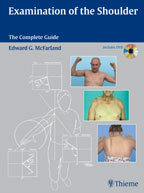Examination of the Shoulder
FROM THE PUBLISHER
The complex structure of the shoulder, with its variable pathological
conditions of rotator cuff disease, degenerative joint disease, and
Type II SLAP lesions, makes clinical examination and assessment
difficult. With this text you will gain a full understanding of
shoulder anatomy, the principles of physical shoulder examination,
and the processes causing shoulder pain. This text discusses range of
motion measurements, laxity testing, shoulder instability and
presents critical analysis of the usefulness and accuracy of
examination practices.
An accompanying DVD contains narrated footage of the examination
techniques described in the text for easy comprehension and review.
You will also find examples of abnormal findings and biomechanical
models demonstrating the complexity of shoulder motion. No
orthopaedic surgeon, orthopaedic resident, physical therapist or
athletic trainer should be without this outstanding text and DVD.
Content
Foreward by Frank W. Jobe (UCLA).
1. General Principles of Shoulder Examination
2. Shoulder Range of Motion
3. Strength Testing
4. Rotator Cuff Disease and Impingement
5. Instability and Laxity
6. Examination of the Biceps Tendon and Superior Labrum Anterior and
Posterior (SLAP) Lesions
7. The Acromioclavicular and Sternoclavicular Joints
Appendix. Statistical Terms and Analysis


